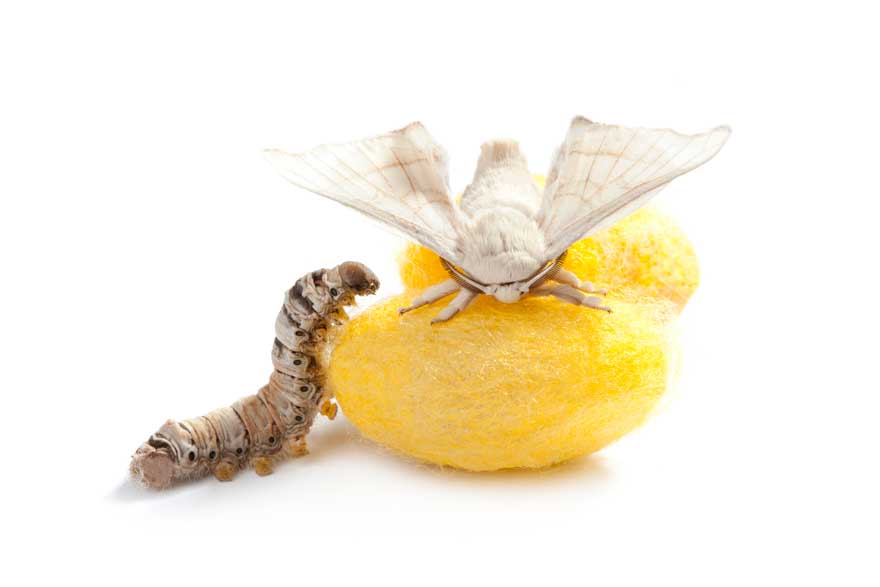Silk Protein - The Luxury Addition
They don't call it 'smooth as silk' for nothing. Silk is synonymous with luxury – the ultimate softness, the highest attainable smoothness, and the most perfect shine.
Silk products of all kinds have been coveted and traded for hundreds of years. Silk is also a popular cosmetics ingredient. Today, we're going to take a closer look at how this ingredient makes its way into hair and skincare products.
Silkworms at Work
Silkworms are amazingly productive little creatures – each one producing up to a mile of thread within a mere 2-3 days! The ancient Chinese were the first to develop the process of creating cloth from these precious, protein-rich threads.
It is also from the threads that the protein is 'extracted' and used for skin and hair care.
The Process of Hydrolysis
By nature, silk protein molecules are 'too big to work with' (read: you can't just add silk threads to a shampoo or body wash and expect them to have any beneficial function).
The proteins need to be broken down into smaller units (until they are water soluble). The process of breaking down (any) protein into tiny bits is called hydrolysis, resulting in an end product called Hydrolized Silk Protein.
For once, the INCI name for it is as straightforward as you please (INCI: Hydrolized Silk Protein).
Superior Conditioning For Hair
Silk protein has some fantastic abilities. Applied to hair, it forms a fine, transparent film that protects the hair cuticle.
It also helps to detangle the hair and promotes shine, elasticity and resiliency. Silk protein is an effective moisturizer for hair, adding luster, body, and manageability.
Silk is quite simply the ultimate luxury for any hair product.
Great For Skin Too
In skincare, silk protein has water-binding properties, making it a great moisturizer. There are some claims that it has antioxidant properties, but to my knowledge, this is 'being studied' and there are as yet no results from the scientific world on this.The A-B Silk Tests
As I have mostly used silk protein in shampoos and body washes so I'll be commenting on how it works in the bath products I've made.
I have tried numerous combinations and dosages – also to see if there was a noticeable difference. The tests were set up as 'A-B' tests.
An example: I will make a batch of shampoo and split it into 2 parts:
'A' (with added silk protein),
'B' (without added silk protein)
I will then test the 2 for a period of time.
My impressions: even with a small dose, silk protein makes a noticeable difference.
'A' (with added silk protein),
'B' (without added silk protein)
I will then test the 2 for a period of time.
My impressions: even with a small dose, silk protein makes a noticeable difference.
I'm absolutely sold on the luxurious feel and added softness (both to hair and skin). I have even A-B tested my own silk-shampoo for hand-washing silk garments against a few different commercial 'specially-made-for-silks-and-delicates-detergents'.
There was absolutely no contest. I have been making and using my own 'silk wash' ever since. It even works in the machine on the 'super-delicate' cycle.
So far, I have been working with hydrolized silk protein, but would like to source a plant-based replacement – preferrably one that can do everything the silk protein can.
There was absolutely no contest. I have been making and using my own 'silk wash' ever since. It even works in the machine on the 'super-delicate' cycle.
The Deep Sea Alternative to Silkworms
Although silk protein is has been used as an addition to cosmetics and hair care products for years (even in some cruelty-free brands), plant-based alternatives are beginning to make their way to the market.So far, I have been working with hydrolized silk protein, but would like to source a plant-based replacement – preferrably one that can do everything the silk protein can.
I am therefore in the process of testing a viable plant-based alternative. It is derived from marine algae and has an equally straightforward INCI name. (INCI: Hydrolized Vegetable Protein).
More on that as soon as I have finishedfooling around with testing it.
More on that as soon as I have finished


Comments